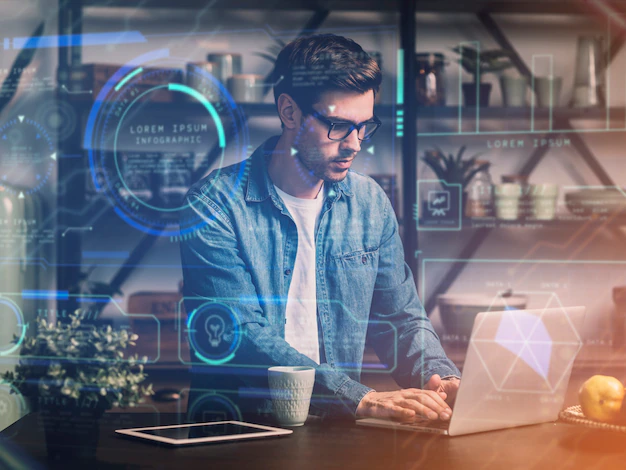The Art Of Automation: Streamlining Marketing Processes With Tech

Automation is a paradigm change that has emerged in today’s dynamic marketing environment, driven by the advancement of technology and strategy working together. This complex mix of strategic finesse and digital competence is reshaping the landscape of marketing tactics.
Welcome to an investigation of this revolutionary force, a story that threads through the maze-like passageways where inventiveness and operational acumen meld together perfectly. On this journey, we explore a previously unexplored area where technology’s deft manipulation of marketing tactics reveals a precision and efficiency tapestry.
A new chapter in the always-changing marketing story will begin as the journey unveils the artistry of using technology wonders to orchestrate the symphony of simplified operations and precision-targeted campaigns.
The Evolution of Automation: From Conception to Integration
Automation is a story that arises as a revolutionary force in the evolution of marketing, from its early conception to its smooth assimilation into modern tactics. When automation first emerged, it was a novel idea and a bright moment when strategy and technology started working together to change how people approached marketing.
This tour takes you through the stages of automation’s transformation and into the halls of marketing history. From its conception as a fresh concept to its development as a pillar of contemporary marketing strategies, the evolution shows its significant influence on campaign accuracy and operational efficiency. Automation is woven into the marketing fabric like a finely woven tapestry, combining the strength of technology with strategic vision to transform marketing at its core.
Harnessing Automation for Enhanced Consumer Engagement
Automation is a key player in modern marketing, serving as a tool for operational efficiency and a designer of better customer interaction. By incorporating it into marketing efforts, firms can establish a closer relationship with their consumers.
Brands may now establish closer ties with their consumers thanks to its incorporation into marketing methods. Automation creates individualized customer journeys by coordinating a symphony of customized interactions. It sorts through enormous amounts of data, finding trends and preferences that let marketers create custom experiences that deeply speak to people’s desires.
Additionally, this technology integration transforms into a channel for immediate engagements, surpassing standard marketing. Brands cultivate enduring relationships by proactively addressing demands and fostering an ongoing discussion through automated touchpoints. Automation precision increases engagement by weaving a story in which businesses synchronize with consumer needs seamlessly, resulting in a strong sense of advocacy and loyalty.
Cloud Storage: A Pillar of Efficiency in Automated Marketing Strategies
The combination of cloud storage and automated tactics signals a monumental shift in modern marketing. Cloud storage is like the much-lauded Backblaze B2 Cloud Storage for automated marketing operations—it’s the cornerstone. It is a highly valuable asset due to its dependability, security, and scalability.
This cutting-edge cloud storage solution empowers marketers, providing an expansive canvas to store and access voluminous data effortlessly. Backblaze B2 Cloud Storage reviews show its reliability, making it a linchpin in preserving, safeguarding, and optimizing marketing assets.
Cloud storage is the silent orchestrator in the symbiotic link between automation and data protection, guaranteeing smooth access and strong operational continuity. Its incorporation gives automated marketing procedures an unmatched efficiency level, ensuring long-term success and flexibility in the ever-changing digital environment.

Overcoming Challenges: Navigating the Terrain of Automated Marketing
There are several tricky obstacles to overcome when navigating the automated marketing landscape. As brands integrate automation into their plans, they face a complex maze of obstacles. Data accuracy is one of these challenges. It’s similar to navigating a maze to ensure data is accurate and relevant; it requires careful inspection and purification procedures to get useful insights without going down the wrong paths.
There is also a dilemma in striking the right balance between automation and customization. It’s like threading a needle through a large web of customer relationships to find the balance where automated interactions retain a human touch. An additional citadel is security. Fortifying defenses in an environment where threats are always changing is necessary to protect the data that powers automation against breaches or misuse. Brands are strengthened when they successfully overcome these obstacles and can use automated marketing while avoiding the many traps.
Automation in the Future: Exploring Innovations and Uncharted Horizons
The future of automated marketing holds both innovation and unexplored territory, offering a scene full of possibilities and complexity. Seeking cutting-edge developments in automated marketing is like sailing on unknown waters. Unlocking the potential of cutting-edge technology like AI, machine learning, and predictive analytics is essential to venture into unexplored areas. These uncharted territories present enormous opportunities for improving and enhancing automated tactics.
However, accessing the terrain of the future requires overcoming difficulties similar to decoding cryptic texts. Innovative solutions are needed to address difficulties, including balancing automation with human touch, complying with strict data protection requirements, and adapting to changing consumer behaviors. Future automation holds both mystery and promise, pushing marketers to forge ahead, revealing previously unheard-of breakthroughs while deftly navigating the challenges inherent in this unexplored region.
The Human Element in Automated Marketing: Balancing Technology and Personalization
Harmonizing the human aspect with technology skills emerges as a complex orchestration in the symphony of automated marketing. Automation drives campaigns toward scale and efficiency, but including the human element in this automated ecosystem is like trying to weave delicate threads into a sturdy cloth. The foundation of customer relationships, personalization, requires a careful balancing act between empathy and algorithms.
Reaching this balance is like creating a work of art. Ensure that every automated touchpoint maintains a feeling of uniqueness. It involves integrating automated procedures with the intuitive artistry of human contact. It’s an art form to integrate the human aspect with computerized marketing. It takes skill to infuse algorithms with the coziness of customization, ensuring that tech-driven advertisements strike a chord with every customer. Achieving this equilibrium perfectly captures how automated marketing has developed into a seamless partnership between technology and human interaction.
Related: Embracing Business Automation: 8 Practices For A Smooth Transition
Conclusion: Embracing the Artistry of Automation in Modern Marketing
In summary, the combination of marketing and automation is more than just a statement of technological convergence; it’s an artistic expression that embodies the harmony of strategy and innovation in the digital sphere. Businesses that embrace the artistic potential of automation will be able to thrive in a future where human creativity and data-driven decision-making coexist.
It’s clear from seeing the world of contemporary marketing that, when applied skillfully, automation complements human creativity rather than diminishes it. It makes marketing’s once-static canvas into a dynamic work of art by providing a platform for tailored interactions, strategic insights, and expedited processes.
Businesses that embrace this artistry streamline processes and develop compelling stories that leave a lasting effect on viewers. The symphony of automation and human ingenuity in this expansive composition reflects a future where authenticity and innovation thrive together, influencing the ever-changing landscape of contemporary marketing.
Read Also:













